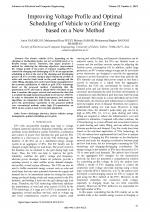| 1/2018 - 10 |
Improving Voltage Profile and Optimal Scheduling of Vehicle to Grid Energy based on a New MethodNAZARLOO, A. |
| View the paper record and citations in |
| Click to see author's profile in |
| Download PDF |
Author keywords
discharges (electric), electric vehicles, energy management, optimal scheduling, power grids
References keywords
grid(23), power(14), vehicle(13), electric(10), vehicles(8), energy(7), plug(6), smart(5), hybrid(5), distribution(5)
Blue keywords are present in both the references section and the paper title.
About this article
Date of Publication: 2018-02-28
Volume 18, Issue 1, Year 2018, On page(s): 81 - 88
ISSN: 1582-7445, e-ISSN: 1844-7600
Digital Object Identifier: 10.4316/AECE.2018.01010
Web of Science Accession Number: 000426449500010
SCOPUS ID: 85043286801
Abstract
The electric vehicles (EVs), depending on the charging or discharging modes, can act as flexible loads or as flexible energy sources. Therefore, this paper proposes a method for achieving the following objectives: improvement the voltage profile of the point of common coupling (PCC), control the charging and discharging of EVs in an appropriate scheduling so that at the end of the charging and discharging process all EVs are fully charged, improvement the profiles of active and reactive loads based on the peak shaving and the valley filling, charging rate control and energy management for the economic justification of vehicle to grid (V2G) technology based on the proposed method. Considering that the penetration of EVs and state of charge (SOC) of battery at any time is random, this paper extracts and analyzes the data that is available through national household travel surveys (NHTS). In order to determine the desired parameters, two stochastic algorithms are integrated with Monte Carlo simulations. To prove the performance superiority of the proposed method over conventional methods under high EVs-penetration, an IEEE 14-bus system is used for real-time simulation. |
| References | | | Cited By |
Web of Science® Times Cited: 5 [View]
View record in Web of Science® [View]
View Related Records® [View]
Updated today
SCOPUS® Times Cited: 6
View record in SCOPUS® [Free preview]
View citations in SCOPUS® [Free preview]
[1] A comprehensive review of demand side management in distributed grids based on real estate perspectives, Dahiru, Ahmed Tijjani, Daud, Dzurllkanian, Tan, Chee Wei, Jagun, Zainab Toyin, Samsudin, Salfarina, Dobi, Abdulhakeem Mohammed, Environmental Science and Pollution Research, ISSN 1614-7499, Issue 34, Volume 30, 2023.
Digital Object Identifier: 10.1007/s11356-023-25146-x [CrossRef]
[2] Coordinated charging and discharging control of electric vehicles to manage supply voltages in distribution networks: Assessing the customer benefit, Nimalsiri, Nanduni I., Ratnam, Elizabeth L., Mediwaththe, Chathurika P., Smith, David B., Halgamuge, Saman K., Applied Energy, ISSN 0306-2619, Issue , 2021.
Digital Object Identifier: 10.1016/j.apenergy.2021.116857 [CrossRef]
[3] Real Measure of a Transmission Line Data with Load Fore-cast Model for The Future, YILMAZ, Musa, Balkan Journal of Electrical and Computer Engineering, ISSN 2147-284X, Issue 2, Volume 6, 2018.
Digital Object Identifier: 10.17694/bajece.419646 [CrossRef]
[4] Research on the effect of large-scale electric vehicle based on smart wearable equipment access to grid, Cai, Li, Hu, Pengqiu, Tan, Zefu, Journal of Ambient Intelligence and Humanized Computing, ISSN 1868-5137, Issue 8, Volume 10, 2019.
Digital Object Identifier: 10.1007/s12652-018-1041-7 [CrossRef]
[5] On supply demand coordination in vehicle-to-grid — A brief literature review, Jia, Qing-Shan, 2018 33rd Youth Academic Annual Conference of Chinese Association of Automation (YAC), ISBN 978-1-5386-7255-6, 2018.
Digital Object Identifier: 10.1109/YAC.2018.8406532 [CrossRef]
Disclaimer: All information displayed above was retrieved by using remote connections to respective databases. For the best user experience, we update all data by using background processes, and use caches in order to reduce the load on the servers we retrieve the information from. As we have no control on the availability of the database servers and sometimes the Internet connectivity may be affected, we do not guarantee the information is correct or complete. For the most accurate data, please always consult the database sites directly. Some external links require authentication or an institutional subscription.
Web of Science® is a registered trademark of Clarivate Analytics, Scopus® is a registered trademark of Elsevier B.V., other product names, company names, brand names, trademarks and logos are the property of their respective owners.
Faculty of Electrical Engineering and Computer Science
Stefan cel Mare University of Suceava, Romania
All rights reserved: Advances in Electrical and Computer Engineering is a registered trademark of the Stefan cel Mare University of Suceava. No part of this publication may be reproduced, stored in a retrieval system, photocopied, recorded or archived, without the written permission from the Editor. When authors submit their papers for publication, they agree that the copyright for their article be transferred to the Faculty of Electrical Engineering and Computer Science, Stefan cel Mare University of Suceava, Romania, if and only if the articles are accepted for publication. The copyright covers the exclusive rights to reproduce and distribute the article, including reprints and translations.
Permission for other use: The copyright owner's consent does not extend to copying for general distribution, for promotion, for creating new works, or for resale. Specific written permission must be obtained from the Editor for such copying. Direct linking to files hosted on this website is strictly prohibited.
Disclaimer: Whilst every effort is made by the publishers and editorial board to see that no inaccurate or misleading data, opinions or statements appear in this journal, they wish to make it clear that all information and opinions formulated in the articles, as well as linguistic accuracy, are the sole responsibility of the author.





